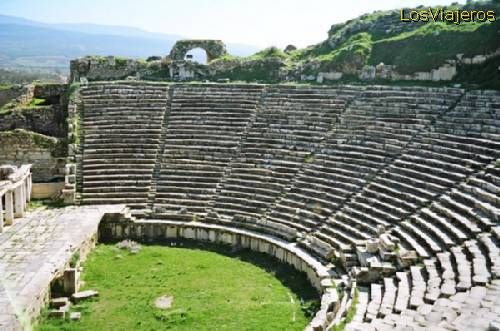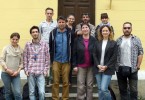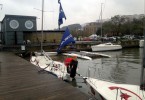News,etc
Some say that Aphrodisias, in inland Aegean Anatolia is the most enchanting site in Turkey and they may be right. Ephesus is too large and well organized to be as appealing and Troy, as charming and mythical a picture as it conjures up, has not been sufficiently unearthed.
Aphrodisias falls between the two. It covers a surface area of 500 hectares within the fortification walls and contains one of Anatolia’s most awe inspiring stadiums -250 meters long and 140 meters wide with a 20,000 spectators capacity. With excavations still incomplete the site offers plenty of ruins for amateur archaeologists to reconstruct in their minds.
Aphrodisias is not easy to reach, which is one reason why it has not attracted much attention from archaeologists or tourists until recently. On a plateau of 600 meters altitude, the site is 100 kilometers from the inland Aegean town of Aydin and 106 kilometers from Denizli, where Pamukkale is situated.
Aphrodisias’ resurrection is an interesting story in itself; the village of Geyre named after the antique region of Caria was constructed within Aphrodisias fortification walls in the 18th century. By that time, the ancient site had long being covered by soil and forgotten, having suffered several earthquakes and raids. The inhabitants of Geyre grew crops on the ancient site built their houses with the pillars and stones that once supported Aphrodias temples and washed their clothes in conveniently shaped sarcophagi.
In 1957, the villagers started digging an irrigation ditch and stumbled over more and more obstacles-things like sculptures and friezes- as they advanced. Finally, they decided to show the objects they had recovered to local museum curators. In 1959, the Turkish government moved the entire village off the site to a new location 1,5 kilometers away. It happened that the village, nestled upon a tumulus, was sitting atop a 5,000 seat theatre now almost fully excavated.
Turkish archaeologist professor Kenan Erim of New York University describes his first trip to the site in 1959 in the August issue of the National Geographic:
“Perched on a protruding marble block, I scanned the weed grown trench dug by the farmers. With caution, we descended into it suddenly I grasped at something I saw embedded in the side of the trench. Pointing, I called out to William Crovello, photographer of our team. We both shouted, “Look! There is a marble head! The head was a woman’s unusually beautiful.”
The lady’s gently waved hair was drawn to the nape of her neck, and she wore a diadem as well as a curious tiara like head dress with the shape of towers and fortification walls, which I recognized as the crown symbolic of the personification of the city.
Indeed, when Erim matched the marble head with the body of a headless frieze previously found by villagers, he saw that he had completed a frieze of the formal emblem of the city of Aphrodisias.
Erim was not the first, though, to excavate Aphrodisias. In 1904-5, French engineer Paul Gaoudin, and in 1937 Italian scholar Julio Jacobi excavated sculptures and friezes which he later sent to the Izmir Museum. And yet most of Aphrodisias treasures were still underground before Erim’s arrival.
The site named after Mother Goddess of Love, Fertility and Life, Aphrodite, had been home for much earlier inhabitants than the Romans, under whom the city reached its apogee. According to archaeologist Semih Tulay, the site had been inhabited as far back as 5800 BC.
Byzantine historian Stephan 5-6th AD wrote that Aphrodisias was previously known as Ninoe which derived from the legendary god of Babylon Ninos. Later, the city acquired such names as Nin, Nino and Astarte. This latter was the name of the Anatolian mother goddess also called Kybele and has some resemblance to Artemis of Ephesus, the Goddess of Fertility, Sky and Earth.
What is already excavated can be grouped into four parts: the theatre, the gymnasium, and theatre baths lie to the south of the site, the spectacular baths of Hadrian to the east, the agora, the Temple of Aphrodite, the Bishop’s Palace, Odeon and the School of Philosophy at the center and the Stadium to the north.
Although the village of Geyre has been moved, residents still plough their plots of land within the site.
Erim writes in the 1967 National Geographic that he had given up trying to convince villagers not to use sarcophagi for pressing grapes:
“The country folk smile and shake their heads, pointing to the clusters of grapes carved in the stone, you see abi, they say, these were meant to be used for pressing grapes.”







